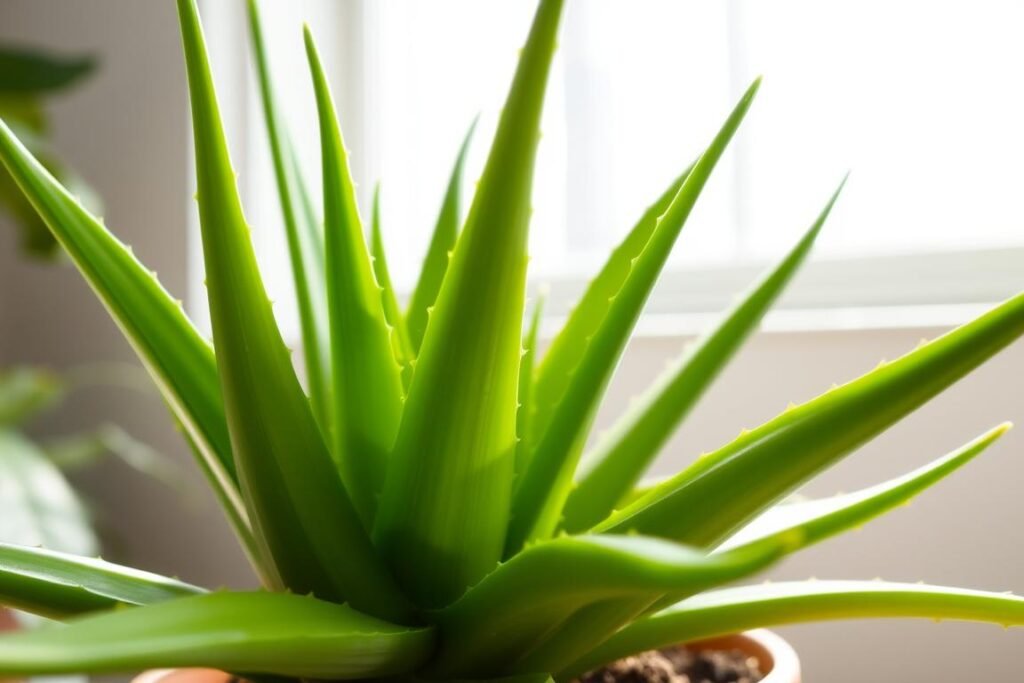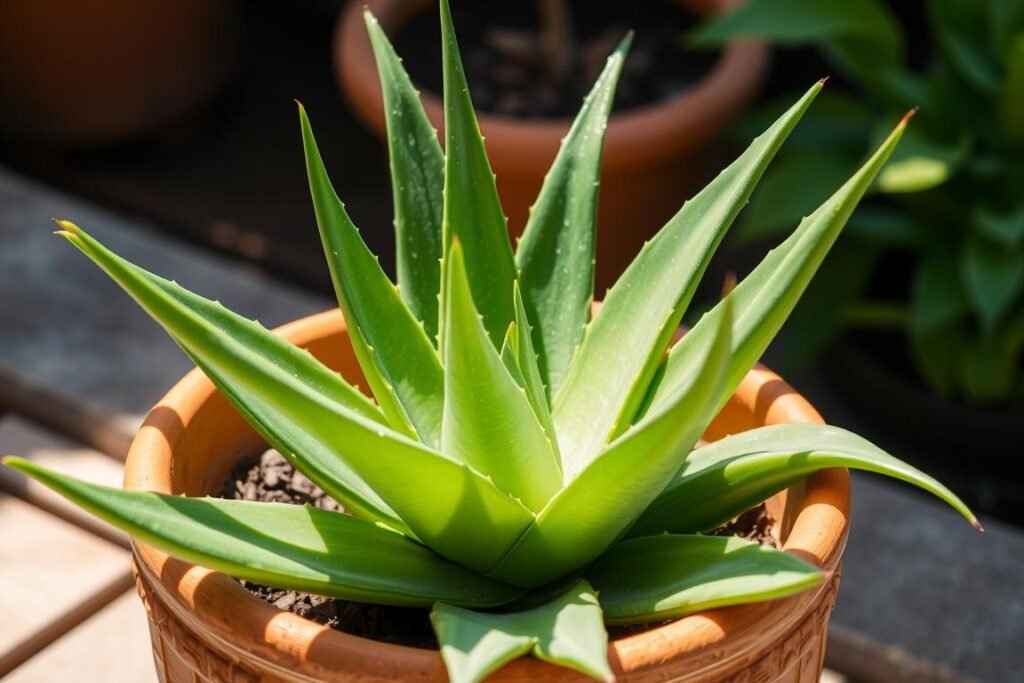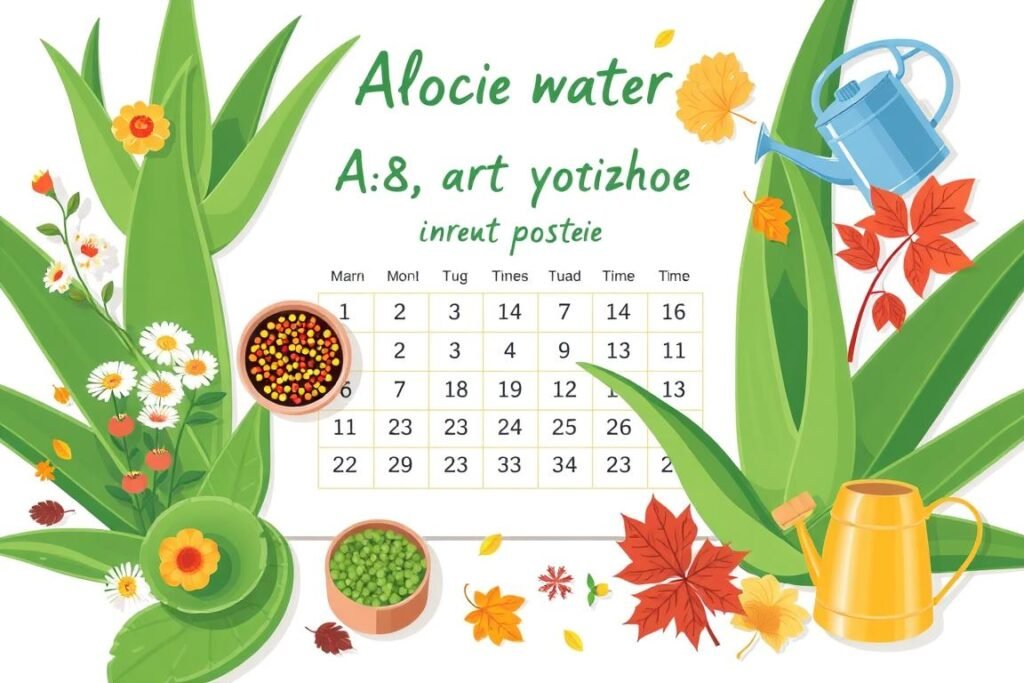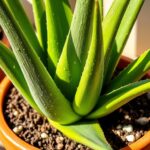I love plants, and aloe vera is one of my favorites. They are tough and can grow in many places. But, do they need food to grow well?

Key Takeaways
- Aloe vera plants are low-maintenance succulents that can survive with minimal nutrients, but occasional fertilization can benefit their health and growth
- A balanced NPK ratio of 1-1-1 or 2-1-1 is recommended for optimal aloe vera blooming
- Organic fertilizers like Fox Farm Big Bloom or Espoma Organic Flower-tone 3-4-5 can promote aloe vera blooms
- Inorganic fertilizers with evenly distributed NPK ratios like 4-4-6, 20-20-20, or 10-10-8 are also suitable for aloe vera plants
- Aloe vera plants grown in containers tend to deplete soil nutrients faster, requiring occasional feeding with liquid or slow-release fertilizer
Understanding Aloe Vera’s Natural Growing Requirements
Aloe vera plants love dry places and poor soil. They grow well in sandy or rocky soil with little organic matter. Knowing what aloe vera needs is key to keeping them healthy and long-lived.
Desert Plant Adaptation and Nutrient Needs
Aloe vera plants are made for dry, harsh places with little food. They store water in their leaves, so they don’t need to drink much. They also don’t need much food, doing well in soil with little organic matter.
Natural Growing Conditions in Wild Habitats
In the desert, aloe vera plants like sandy or rocky soil. This soil is slightly acidic to neutral, which they prefer. The desert’s sparse plants and low organic matter help aloe vera plants grow well.
Basic Soil Requirements for Healthy Growth
To make aloe vera plants happy, use a well-draining soil mix. A sandy, gritty mix is best, as it lets roots breathe. Keep the soil’s pH between 6.0 and 7.0 for the best growth.
By knowing what aloe vera plants need, gardeners can make a great home for them. This lets these tough plants thrive and grow well.
Do Aloe Vera Plants Need Fertilizer and What Kind Is Best
Aloe vera plants are easy to care for. They grow well in many places. But, they do need some food now and then to stay healthy.
The best food for them is liquid 10-40-10 houseplant mixes or special succulent fertilizers. These foods have the right mix of nutrients for aloe vera. They help the roots grow strong and the plant to grow well.
For aloe vera in pots, feed them once a month in spring and summer. If they’re in the garden, feed them once in early spring. Too much food can hurt the plant, so don’t overdo it.
| Fertilizer Type | Ideal NPK Ratio | Frequency of Application |
|---|---|---|
| Liquid Houseplant Fertilizer | 10-40-10 | Monthly during growing season |
| Specialized Succulent Fertilizer | Varies, but high in phosphorus | Monthly during growing season |
| Garden-Grown Aloe Vera | 10-40-10 | Once in early spring |
By using the right aloe vera houseplant fertilizer, your aloe vera plants will stay healthy and look great.
“Aloe vera is a versatile and resilient plant that can enhance any indoor or outdoor space. With the right care and occasional feeding, it can reward you with its unique beauty and numerous benefits.”

Types of Fertilizers Suitable for Aloe Vera
Aloe vera plants are easy to care for. They do well in dry places with sandy soil. They don’t need a lot of food but some nutrients help them grow strong.
There are organic and inorganic fertilizers for aloe vera. The choice depends on what you like and what your plants need.
Organic Fertilizer Options
Organic fertilizers are good for aloe vera. They give nutrients slowly and keep the soil healthy. Here are some organic options:
- Compost tea: A liquid full of nutrients that you can water your plants with.
- Chopped banana peels: They give potassium, which is good for aloe vera.
- Ground eggshells: They add calcium and other minerals gently.
Chemical Fertilizer Recommendations
If you prefer inorganic fertilizers, pick ones with a balanced NPK ratio. Aloe vera doesn’t need a lot of nitrogen. Look for fertilizers with a lower nitrogen content, like 4-4-6 or 10-10-8.
Stay away from urea-based nitrogen fertilizers. Aloe vera can’t use this type of nitrogen well.
Good inorganic fertilizers for aloe vera include low-nitrogen bromeliad fertilizers. Fox Farm Big Bloom or Espoma Organic Flower-tone 3-4-5 are good choices.
NPK Ratios and Their Importance
The NPK ratio shows the amount of each nutrient in a fertilizer. For aloe vera, a balanced ratio with more phosphorus and potassium is best. These nutrients help with root growth, flowers, and overall health.
Using fertilizers with the right NPK balance helps your aloe vera plants grow well.
Knowing what aloe vera plants need helps you pick the best fertilizers. This way, your plants will grow strong and stay healthy for a long time.
When and How to Fertilize Aloe Plants
Aloe vera plants do well with little food, especially outside. But, giving them the right food at the right time helps them grow strong. Knowing when and how to feed them is key.
Spring and summer are the best times to feed aloe vera. Use a weak liquid fertilizer every 1-2 weeks then. In winter, cut back to once every 2-3 weeks. This keeps your aloe healthy without harming it.
Before feeding potted aloe vera, water it well the day before. This stops fertilizer burn on the roots. For garden aloe, a single early spring feeding is enough.
Don’t use solid fertilizers because they’re too strong for aloe vera’s roots. Choose liquid or water-soluble ones made for cacti and succulents. These keep your aloe healthy without making it grow too fast.

Feeding your aloe vera at the right time is crucial. Don’t feed it when it’s sleeping or stressed. Too much food can hurt it. A balanced feeding schedule keeps your aloe looking great.
Signs of Over-Fertilization and Nutrient Deficiency
As an aloe vera fan, knowing the signs of too much fertilizer and not enough nutrients is key. Spotting these problems early helps keep your plants healthy and bright.
Recognizing Fertilizer Burn Symptoms
Yellow or wilted leaves, especially the bottom ones, show too much fertilizer. You might see dark-brown spots or a white crust on the soil. These signs mean fertilizer burn, harming the plant’s cells and drying it out.
Identifying Nutrient Deficiencies
Aloe vera plants can also show signs of not getting enough nutrients. Look for slow growth, color changes, or other signs. Not getting enough nitrogen, phosphorus, or potassium can make leaves pale or change color. Fixing these issues is key to keeping your plant healthy and growing well.
Corrective Measures for Fertilizer Problems
If you think you’ve over-fertilized, start by watering the plant well. This helps remove extra nutrients. If it’s really bad, you might need to move the plant to new soil. Use less fertilizer and choose a slow-release, balanced formula.
For not enough nutrients, change how often you fertilize. Make sure your plant gets enough sunlight and has good soil. A balanced, organic fertilizer or a special supplement can help fix the problem and help your plant grow.
By watching closely and fixing problems right away, you can keep your aloe vera plant health in check. This way, your plants will do well and give you lots of benefits.
Conclusion
Aloe vera plants can grow well with little care. But, sometimes, fertilizing them can help them grow more. This might even make them bloom.
To keep my aloe vera plants healthy, I’ll fertilize them lightly during the growing season. I’ll also make sure they get enough water, have good soil, and lots of sunlight. These plants are easy to care for, making them great for anyone who loves plants.
By following these tips, my aloe vera plants will do well. They will add beauty and clean air to my space. Aloe vera plants are special because they can bloom and help purify the air.
FAQ
Do aloe vera plants need fertilizer?
Aloe vera plants can get better with some fertilizer, especially in pots. But they’re easy to care for. They can grow well in poor soil.
What kind of fertilizer is best for aloe vera plants?
The top choices for aloe vera are liquid 10-40-10 mixes or succulent fertilizers. Remember, don’t overdo it. Too much fertilizer can hurt your plant.
What are the basic soil requirements for healthy aloe vera growth?
Aloe vera needs soil that drains well, like sand or rocks. It should be low in organic matter and slightly acidic to neutral. They thrive in poor soil.
What types of fertilizers are suitable for aloe vera plants?
Both organic and inorganic fertilizers work for aloe vera. Organic options include compost tea, banana peels, and eggshells. For inorganic, look for balanced NPK ratios like 4-4-6, 20-20-20, or 10-10-8.
When and how should I fertilize my aloe vera plant?
Fertilize aloe vera in spring and summer when they’re growing. Use a little fertilizer, about once a week or two. Cut back to every 2-3 weeks when they’re dormant. For potted plants, use diluted liquid fertilizer. For garden plants, fertilize once in spring.
How do I recognize and correct over-fertilization or nutrient deficiencies in aloe vera?
Too much fertilizer can cause yellow leaves, wilting, dark spots, or a white crust on soil. Nutrient lack shows as slow growth or color changes. To fix over-fertilization, water the plant well. For nutrient lack, change your fertilizing schedule and make sure the plant has good growing conditions.






